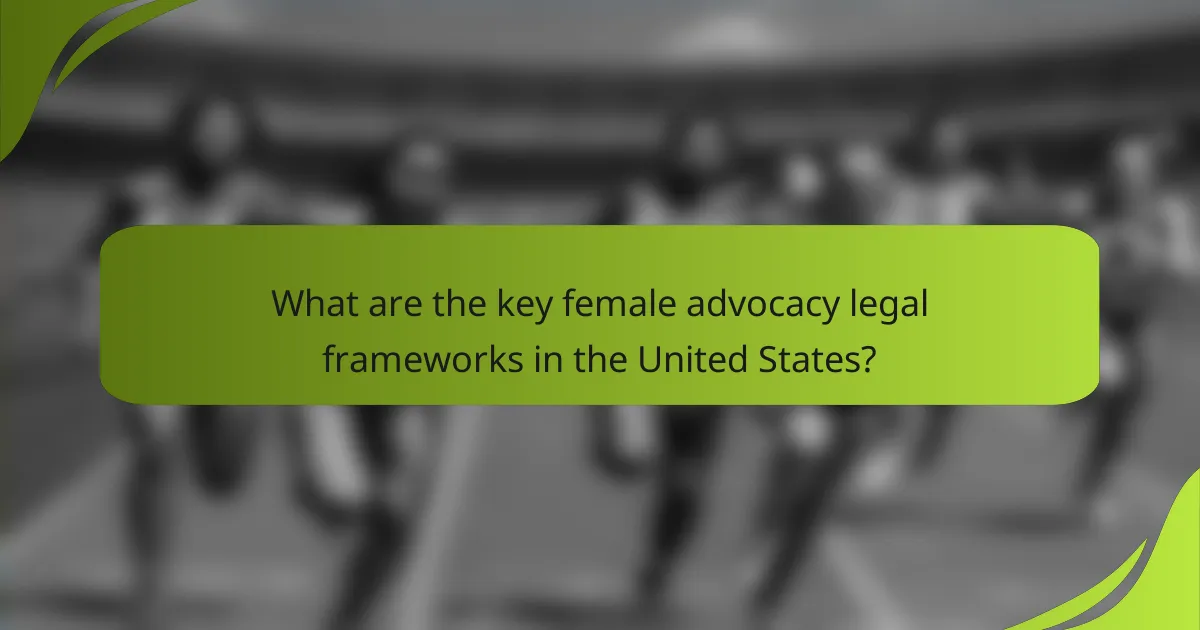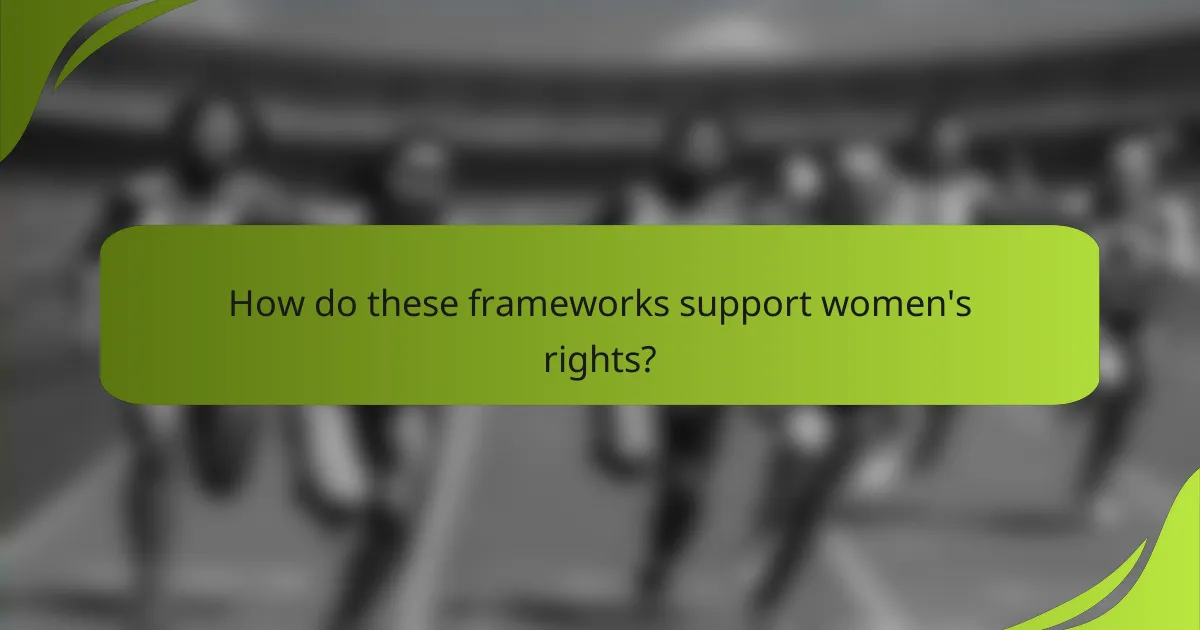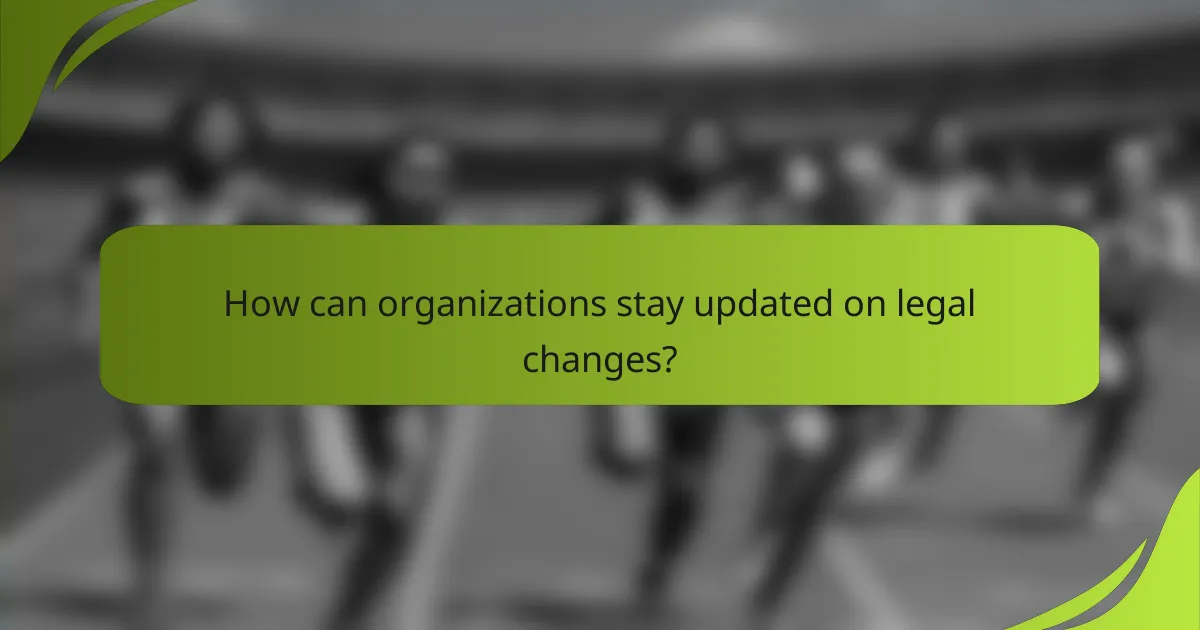Female advocacy legal frameworks in the United States are crucial for safeguarding women’s rights and advancing gender equality. These laws tackle significant issues such as workplace discrimination, domestic violence, and access to education, ensuring that women receive the protections and support they need. To comply with these frameworks, organizations must adopt anti-discrimination policies, offer training, and perform regular assessments to foster an equitable environment.

What are the key female advocacy legal frameworks in the United States?
The key female advocacy legal frameworks in the United States include various laws designed to protect women’s rights and promote gender equality. These frameworks address issues such as education, workplace discrimination, domestic violence, and family leave, providing essential protections and support for women across the country.
Title IX of the Education Amendments
Title IX is a federal law that prohibits sex-based discrimination in any educational program or activity receiving federal funding. This law ensures that women have equal opportunities in sports, academics, and other school-related activities, promoting gender equity in education.
Under Title IX, schools must take proactive steps to prevent and address sexual harassment and assault. Institutions are required to have policies in place for reporting incidents and providing support to victims, which can include counseling and academic accommodations.
Violence Against Women Act (VAWA)
The Violence Against Women Act (VAWA) is a landmark piece of legislation aimed at addressing domestic violence, sexual assault, and stalking. It provides federal resources to improve criminal justice responses and support services for victims, including shelters and legal assistance.
VAWA has been instrumental in funding programs that help victims navigate the legal system and access essential services. It emphasizes the importance of community-based responses and encourages collaboration between law enforcement, service providers, and advocacy groups.
Equal Pay Act
The Equal Pay Act mandates that men and women receive equal pay for equal work in the same establishment. This law aims to eliminate wage discrimination based on sex, ensuring that women are compensated fairly for their contributions in the workplace.
Employers must evaluate their pay structures regularly to identify and rectify any disparities. Employees can file complaints with the Equal Employment Opportunity Commission (EEOC) if they believe they are victims of wage discrimination, leading to potential investigations and remedies.
Pregnancy Discrimination Act
The Pregnancy Discrimination Act prohibits discrimination based on pregnancy, childbirth, or related medical conditions. This law ensures that pregnant employees are treated the same as other employees with similar abilities or limitations, protecting their rights in the workplace.
Employers are required to provide reasonable accommodations for pregnant workers, such as modified duties or flexible schedules. It is crucial for employees to communicate their needs and understand their rights under this act to ensure proper support.
Family and Medical Leave Act (FMLA)
The Family and Medical Leave Act (FMLA) allows eligible employees to take up to 12 weeks of unpaid leave for specific family and medical reasons, including the birth or adoption of a child or serious health conditions. This law helps employees balance work and family responsibilities without fear of losing their jobs.
To qualify for FMLA, employees must work for a covered employer and meet certain criteria, such as having worked a minimum number of hours. Understanding the application process and notifying employers in advance can help ensure a smooth leave experience.

How do these frameworks support women’s rights?
Legal frameworks supporting women’s rights provide essential protections and promote equality in various aspects of life. They address discrimination, ensure access to education and employment, and offer support for victims of violence, creating a more equitable society.
Protection against discrimination
Legal frameworks against discrimination are crucial for safeguarding women’s rights in workplaces, educational institutions, and public services. These laws often prohibit unfair treatment based on gender, ensuring that women have equal opportunities and protections under the law.
For instance, many countries have enacted legislation that mandates equal pay for equal work, which helps to close the gender wage gap. Organizations must comply with these laws to avoid penalties and foster a more inclusive environment.
Access to education and employment
Access to education and employment is a fundamental right supported by various legal frameworks. These laws aim to eliminate barriers that women face in pursuing education and career opportunities, promoting gender equality in both sectors.
Programs and initiatives may include scholarships for women in STEM fields or quotas for female representation in certain industries. Employers are encouraged to implement family-friendly policies, such as flexible working hours, to support women in balancing work and family responsibilities.
Support for victims of violence
Legal frameworks provide critical support for victims of violence, including domestic abuse and sexual harassment. These laws often establish protective measures, such as restraining orders, and ensure that victims have access to necessary resources like shelters and counseling services.
Additionally, many jurisdictions have specific laws that mandate training for law enforcement and judicial personnel to handle cases of violence against women sensitively and effectively. This ensures that victims receive the support they need while navigating the legal system.

What compliance measures are necessary for organizations?
Organizations must implement a range of compliance measures to ensure adherence to female advocacy legal frameworks. Key measures include establishing anti-discrimination policies, providing training programs for staff, and conducting regular audits and assessments.
Implementing anti-discrimination policies
Anti-discrimination policies are essential for fostering an inclusive workplace. These policies should clearly define unacceptable behaviors, outline reporting procedures, and specify consequences for violations. Organizations should ensure that these policies are communicated effectively to all employees.
To create effective anti-discrimination policies, consider involving employees in the development process. This can enhance buy-in and ensure the policies address real concerns. Regularly reviewing and updating these policies is also crucial to reflect changes in laws and societal norms.
Training programs for staff
Training programs are vital for educating staff about anti-discrimination policies and promoting a culture of respect. These programs should cover topics such as unconscious bias, diversity, and inclusion, and provide practical scenarios for employees to engage with.
Consider implementing mandatory training sessions at least annually, with additional refresher courses as needed. Tailoring training to specific roles within the organization can also enhance its effectiveness, ensuring that all employees understand their responsibilities in upholding these policies.
Regular audits and assessments
Conducting regular audits and assessments helps organizations evaluate the effectiveness of their compliance measures. These audits can identify gaps in policy implementation and areas for improvement, allowing organizations to take corrective action promptly.
Establish a schedule for audits, such as semi-annually or annually, and involve third-party experts if necessary to ensure objectivity. Use the findings from these assessments to inform future training and policy adjustments, creating a continuous improvement cycle in compliance efforts.

What are the penalties for non-compliance?
Penalties for non-compliance with female advocacy legal frameworks can include substantial fines, loss of federal funding, and significant reputational damage. Organizations must understand these risks to ensure adherence to regulations and maintain their operational integrity.
Fines and legal repercussions
Organizations that fail to comply with female advocacy regulations may face fines that can range from thousands to millions of dollars, depending on the severity of the violation. Legal repercussions can also include lawsuits, which may lead to costly settlements or judgments against the organization.
It is crucial for organizations to regularly review their compliance status and implement necessary changes to avoid these financial penalties. Establishing a compliance officer or team can help monitor adherence to legal requirements and mitigate risks.
Loss of federal funding
Non-compliance can result in the loss of federal funding, which is often critical for organizations that rely on government grants or contracts. This loss can severely impact operational capabilities and limit resources available for advocacy efforts.
To prevent funding loss, organizations should maintain accurate records of compliance efforts and engage with federal agencies to clarify any regulatory uncertainties. Regular audits and assessments can also help identify potential compliance issues before they escalate.
Reputational damage
Reputational damage from non-compliance can be long-lasting and detrimental to an organization’s mission. Negative publicity can lead to a loss of trust among stakeholders, including donors, clients, and the community.
To protect their reputation, organizations should prioritize transparency and proactive communication regarding their compliance efforts. Engaging in community outreach and demonstrating commitment to female advocacy can help rebuild trust and mitigate the effects of any past non-compliance issues.

How can organizations stay updated on legal changes?
Organizations can stay updated on legal changes by actively seeking out reliable sources of information and engaging with relevant communities. Regularly subscribing to legal updates, connecting with advocacy groups, and attending workshops can significantly enhance awareness of evolving regulations.
Subscribe to legal updates
Subscribing to legal updates from reputable sources is a straightforward way to stay informed. Many law firms, legal organizations, and government agencies offer newsletters or alerts that summarize recent changes in legislation and compliance requirements.
Consider setting up alerts for specific topics relevant to female advocacy, such as gender equality laws or workplace discrimination regulations. This proactive approach ensures you receive timely information directly related to your organization’s interests.
Engage with advocacy groups
Engaging with advocacy groups can provide valuable insights into legal changes affecting women. These organizations often have their fingers on the pulse of legislative developments and can offer guidance on best practices for compliance.
Joining networks or forums related to female advocacy allows organizations to share experiences and strategies. This collaboration can lead to a deeper understanding of the legal landscape and help in navigating complex regulations effectively.
Attend relevant workshops and seminars
Attending workshops and seminars focused on legal compliance and advocacy can be highly beneficial. These events often feature experts who discuss recent changes in laws and provide practical advice on implementation.
Look for local or online events that cover topics such as workplace rights, anti-discrimination laws, or compliance strategies. Participating in these educational opportunities not only enhances knowledge but also fosters connections with other professionals in the field.

What role do advocacy groups play in shaping legal frameworks?
Advocacy groups are crucial in influencing legal frameworks by promoting specific issues and mobilizing public support. They engage with lawmakers, provide research and data, and raise awareness to drive legislative change that aligns with their goals.
Lobbying for legislative changes
Lobbying is a primary tool used by advocacy groups to push for legislative changes that benefit their causes. These organizations often employ lobbyists who interact directly with legislators to present research, share personal stories, and advocate for specific policy adjustments.
Effective lobbying involves understanding the political landscape and identifying key decision-makers. Advocacy groups should focus on building relationships with legislators and their staff, as well as organizing grassroots campaigns to demonstrate public support for their initiatives.
Common strategies include drafting policy proposals, organizing meetings with lawmakers, and mobilizing constituents to contact their representatives. Advocacy groups should ensure they comply with local lobbying regulations, which may vary by region and require transparency in their activities.


